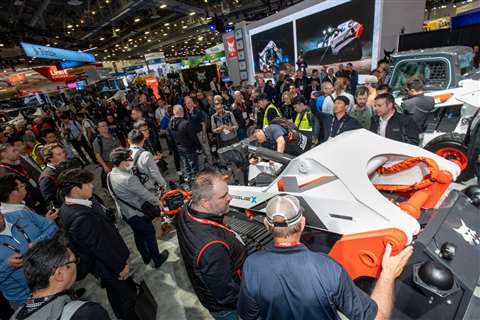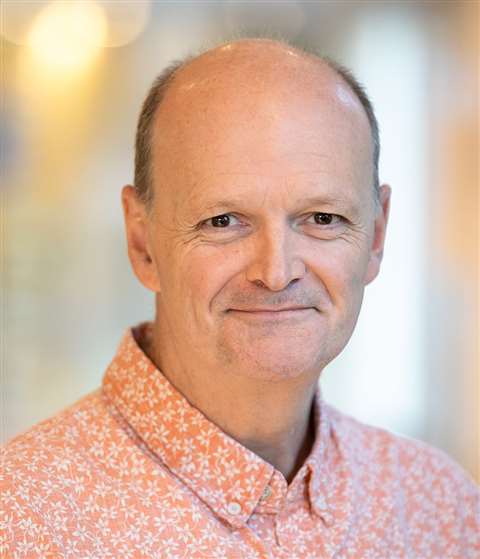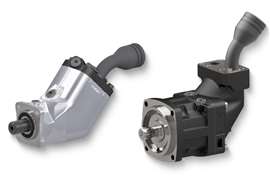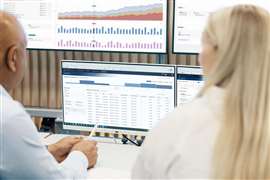Siri’s co-creator on why he thinks construction equipment will never be 100% autonomous
30 June 2023
 Construction industry professionals get their first up-close look at the ROgue X and S7X models. (PHOTO: Bobcat)
Construction industry professionals get their first up-close look at the ROgue X and S7X models. (PHOTO: Bobcat)
Construction machinery will never be 100% autonomous and will always require human supervision.
That’s according to French-born computer scientist Luc Julia, who co-created Apple’s digital assistant Siri and is now chief scientific officer at Renault Group.
Julia’s comments came as he spoke to International Construction about the potential effects of artificial intelligence (AI) on the construction industry.
 Dr Luc Julia (Image: Yves Forestier)
Dr Luc Julia (Image: Yves Forestier)
He has been part of the AI community for nearly 30 years, starting his career at SRI International in California, where he co-founded the Computer Human Interaction Centre (CHIC) and built the first smart car and smart fridge.
He later worked at Apple as director of the Siri project, having co-authored Siri’s core patents at SRI International in the late ‘90s with Siri’s co-founder, Adam Cheyer.
Julia said he did not think that full autonomy in construction machinery was ever likely to happen, in the same way that full autonomy of cars was not possible.
But he could envisage a time when machinery on site operated at nearly full autonomy but with supervision from a remote operator, who could potentially be in charge of keeping an eye on multiple machines.
“When we talk about autonomous driving in general and in particular for cars, we in the AI community have been saying for years that it will never happen. It is just impossible,” Julia said.
“We will have autonomous driving at level 4 [where operation is fully autonomous but a human operator can still request control and the machine still has a cockpit]. But level 5 [where a machine fully replaces traditional human operator tasks] will never exist because of the unpredictability of humans and the world around us. There are dogs, cats, bikes – and a construction site could be even more of a mess, although it could also be more confined.
“We will have almost autonomous – machines that are autonomous for most of the time (and most of the time means 99%). But we cannot say that there won’t be human intervention. At some point, there will have to be some.”
AI can help with design but can’t replace human creativity
On the subject of designing for construction, Julia stresses that while AI tools can enhance and speed up the process, they can’t replace human creativity.
“We didn’t make the mistake of calling AI ‘creative’, we called it ‘generative’,” he said. “It relies on what has been created before by us – something that is already there. When you use Midjourney today, you have prompts. You can say, ‘OK, draw a green car on top of the Eiffel tower.’ The creation was right there in what I said because I had this image in my mind of a green car on top of the Eiffel tower.
“The tool will generate a bunch of images of green cars on top of the Eiffel tower but I am going to take the one that is closest to what is in my mind, take it and generate again and again.
“These tools are incredible in the way they are going to help me to be creative because they are going to give me options that maybe I didn’t think about and they are going to help me to reach the ideal image that I envisioned with my creativity. But they are nothing more than what Photoshop was 25 years ago. Back then, I was able to create images faster because of shortcuts on a keyboard. This is exactly the same thing but much faster.”
Be prepared to use AI
As a result, Julia cautions that the main danger as AI becomes part of everyday working life is not that it will take jobs away from humans but that humans haven’t prepared themselves to use them.
“The main danger is if we do not educate ourselves on how these tools work and we do not train ourselves on how best to use them and how they can help us,” he asserts.
“We used to talk about robots in the ‘60s, ‘70s and ‘80s. Now we talk about ‘cobots’ because we have realized that these robots are nothing without us. They are helpers, helping us to do tasks better but we still need to be there.
“Of course, you may end up with robots taking over some manual tasks like laying bricks but we will always keep the emotional and intellectual tasks,” he adds.
Replacing unwanted tasks
Having spent decades within the AI community, Julia points out that the arrival of tools like ChatGPT is not a revolution but an evolution of technology that has been around for 15-20 years.
Where there is arguably a revolution now is in the user interface (UI), which makes the technology more accessible and more easily applicable to a range of different everyday tasks.
But Julia takes the optimistic view that AI can be used to replace only the tasks that we want it to replace.
“The way AI is going is that tasks that we collectively do not want to perform are going to be removed.
“In construction, if I could build something right now that meant people did not have to perform tasks with a jackhammer, then I would do it right away. If we haven’t replaced the jackhammer yet then there is a reason – it might be more difficult than we think and the robot for that task hasn’t been built yet.”
And he asserts that AI is something to embrace as a way to improve productivity, rather than to fear.
He says, “AI is for real people, to help them to do something that they don’t want to do.”
Luc Julia is the author of There’s no such thing as artificicial intelligence.
POWER SOURCING GUIDE
The trusted reference and buyer’s guide for 83 years
The original “desktop search engine,” guiding nearly 10,000 users in more than 90 countries it is the primary reference for specifications and details on all the components that go into engine systems.
Visit Now
STAY CONNECTED




Receive the information you need when you need it through our world-leading magazines, newsletters and daily briefings.
CONNECT WITH THE TEAM













